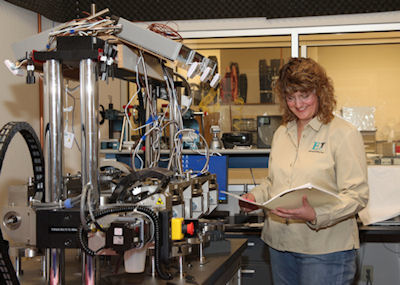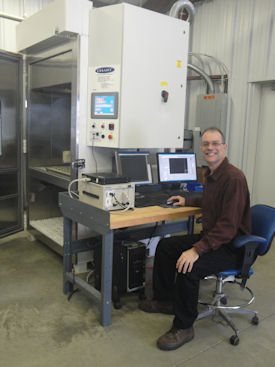
Dawn Lissy inspects the results of a medical device test.
Latest News
April 3, 2014
 Dawn Lissy inspects the results of a medical device test.
Dawn Lissy inspects the results of a medical device test.Product and materials testing services provide the final stamp of approval, allowing new or improved products to graduate from detailed CAD designs into the marketplace. Because of the time and cost involved, however, designers and developers need to understand how to partner effectively with their materials testing facility. The kind of product, the materials used, the product’s intended end use, industry standards and government regulations all affect what kind of testing facility to choose and when to get the facility involved.
Two materials testing experts share their advice with DE on how new product developers can get the best value for their testing dollar: Gary Delserro, specializing in automotive, defense and aerospace product testing; and Dawn Lissy, whose lab focuses exclusively on medical device testing.
Automotive and Aerospace Product Testing
With more than 20 years experience as an aerospace reliability engineer for the Naval Air Warfare Center, Gary Delserro, president of Delserro Engineering Solutions in Easton, PA, performs vibration and shock testing for aerospace, automotive, medical, telecom and military industries. His lab specializes in testing to specifications such as MIL-STD-167, MIL-STD-202, MIL-STD-810, RTCA/DO-160, General Motors, SAE, ISTA and IEC for companies all over the country.
“When we’re doing final testing to meet one of these specifications, it’s important that all the dimensions and shapes of a product are very near the final stage,” says Delserro. “From a test-house point of view, when we have to fabricate complicated fixtures, it creates problems if a product’s dimensions keep changing.”
Delserro explains that designing a new test fixture starts with receiving a CAD file of the product to be tested. This lets his team check dimensions on the computer and make sure everything needed for the test will fit the test fixture. For example, his facility recently built a new test fixture to provide both vibration and temperature testing on proposed new sensors for car engines.
“The fixture design for this test was very complicated,” he recalls. “We had almost 50 sensors that had to be powered on during the test, and monitored for severe extremes of vibration and temperature over a long duration.”
 Gary Delserro sits at his lab’s Highly Accelerated Life Test (HALT) Chamber, which performs combined temperature and vibration loads simultaneously.
Gary Delserro sits at his lab’s Highly Accelerated Life Test (HALT) Chamber, which performs combined temperature and vibration loads simultaneously.Delserro says the complicated fixture took months to design and build, thanks to the amount of cabling, wiring and harness work needed. The final test was successful, but if there had been last-minute changes to the physical configuration of the sensors being tested, they would have had to rebuild the test fixture. That would have cost the designers significant money and time.
On the other hand, Delserro says testing for new product reliability and manufacturability should happen near the beginning of the product design cycle.
“Sometimes reliability test results can change the final design, which would also cause tooling changes,” he adds. “So from a reliability and manufacturability point of view, it’s better to test a new product as early as possible.”
A Different Challenge: Medical Device Testing
“Testing must be a fundamental part of the medical design process,” says Dawn Lissy, co-owner of Empirical Testing Corp. (ETC), Colorado Springs, CO.
Lissy holds a master’s degree in biomedical engineering and has extensive post-graduate experience in new product design and development. Early in her career, she managed maintenance, manufacturing, testing and quality for AcroMed Corp. (now DePuy Spine). As the market for orthopedic and other medical devices grew over the last few decades, however, Lissy founded ETC, which is now an A2LA ISO/IEC 17025:2005 accredited mechanical testing laboratory solely specializing in medical device testing. Her lab tests products from all over the world to meet global regulatory requirements, including U.S. Food & Drug Administration (FDA) and CE marking approval.
Lissy emphasizes the importance of early involvement of the medical device testing facility in the product development lifecycle. She recommends holding a strategy meeting with all stakeholders early in the cycle.
“A good test service should be able to provide developers a number of possible strategies, and be able to explain what differences there might be in the timeline and the results,” she adds. “We always tell our partners there’s the cowboy approach, the conservative approach—which takes the most time but has the least risk—and the middle-of-the-road approach.”
Design engineers need to factor the time needed for testing into their product development lifecycle plans, because each of these test methods will take a specific amount of time, Lissy says.
“Mechanical testing is usually the last step you take before submission to the FDA. And if it takes four to six weeks, it can’t be compressed to two weeks,” she point out. “So early on, you need to plan time in your product development cycle in case you get data you weren’t expecting.”
Facility Considerations
Both Lissy and Delserro agree that product developers need to pick a testing facility that can help them not only run the tests, but also interpret the results.
“We are product reliability engineers who can help our clients develop a test plan, build a custom test setup, and help the designers interpret the results,” says Delserro. “Some labs just run the standard tests to the specs, and don’t provide much help with how to use the data to predict field life.”
Lissy stresses the importance of institutional knowledge: “Designers of medical devices need to be sure that the testing facility they choose has actual experience and is ISO-accredited with the required methodology. At ETC, we often find ourselves testing medical devices that have evolved beyond the existing standards. In medical device testing, everything is custom. There are no across-the-board rules.”
For example, says Lissy, the FDA standard for pedicle screws used in spine fusion and other orthopedic uses lags significantly behind current developments.
“When that standard was developed five to 10 years ago, it only accounted for monolithic screws where the head did not move,” Lissy explains. “Now engineers have developed polyaxial screws that give surgeons more options. If you choose a lab that is not familiar with testing polyaxial screws, they may not adapt the existing standard appropriately.”
Lissy adds that medical device standards are in constant evolution, and keeping up with actual industry-wide standards that are in use, but not yet officially published is essential for a medical device testing facility.“As new technologies evolve, the published standards lag behind,” she notes. “There are many standards under discussion in ASTM committees that have not yet been officially published. So a lab that is not familiar with these may test inappropriately on a whole slew of variables, which would lead to a waste of time and money.”
Because ETC is constantly testing new devices, the company is an active member of the relevant ASTM standards committees that are writing standards for new technology.
Avoiding Stumbling Blocks
According to both Lissy and Delserro, good communication between product designers and the test facility is the single most important factor in ensuring the success and cost-effectiveness of a test.
“We recently had a customer submit their own test plan for us to follow,” recalls Delserro. “It was not very comprehensive, and lacked information on how to set up the product. Then, we got some of the parts one day, some special cables that were needed on another day, and a little later we received the test fixtures. But there were no instructions on how to set everything up.”
Just as they were finally ready to start the test, Delserro’s team discovered they were missing a specific size bolt. Luckily, his facility had enough in stock to complete the setup.
“If we had not had that specific piece of hardware, the test would have been delayed,” he says. “Last-minute changes cause us great hardships, especially if we have to tear down a fixture, because other companies are already in line to use the equipment.”
Lissy says her firm tries to mitigate problems early in the development process by holding a strategy meeting with all the stakeholders. “Once you determine your strategy, you can determine up front your timeline and how many specimens to manufacture,” she continues. “The worst thing you can have happen is when someone only sends us 26 parts and we actually need 36 parts. Then it takes time to get the rest of them.”
In summary, regular communication with your materials testing facility will save your firm time and money in the long run. Something as simple as miscommunication over the number of parts needed for a specific test can cause expensive delays in getting a product to market. Finally, product designers need to look for facilities that can go beyond the currently mandated tests and help interpret data, with an eye to the evolution of the technology and standards in the near future.
Lynne Brakeman is a Cleveland-based writer. Send e-mail about this article to de-editors@digitaleng.news
More Info
Subscribe to our FREE magazine, FREE email newsletters or both!
Latest News
About the Author
DE’s editors contribute news and new product announcements to Digital Engineering.
Press releases may be sent to them via DE-Editors@digitaleng.news.






